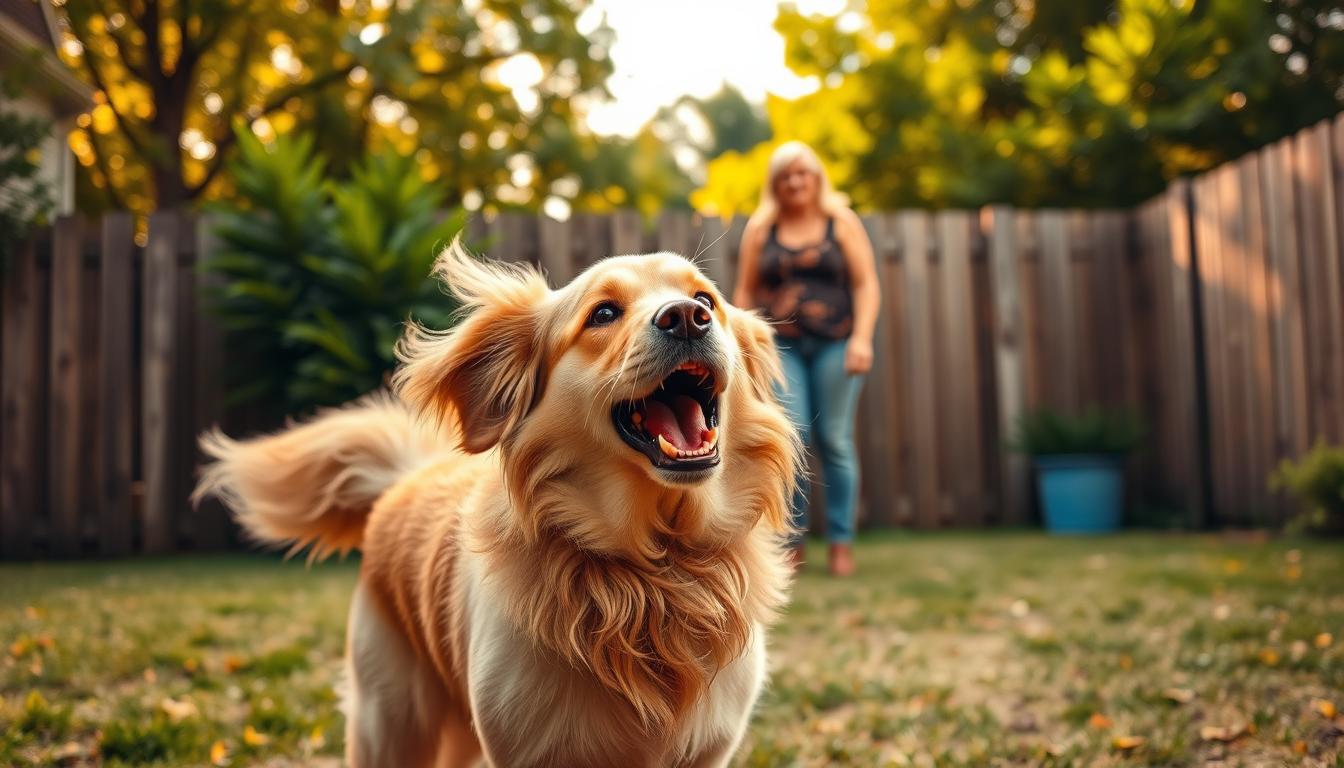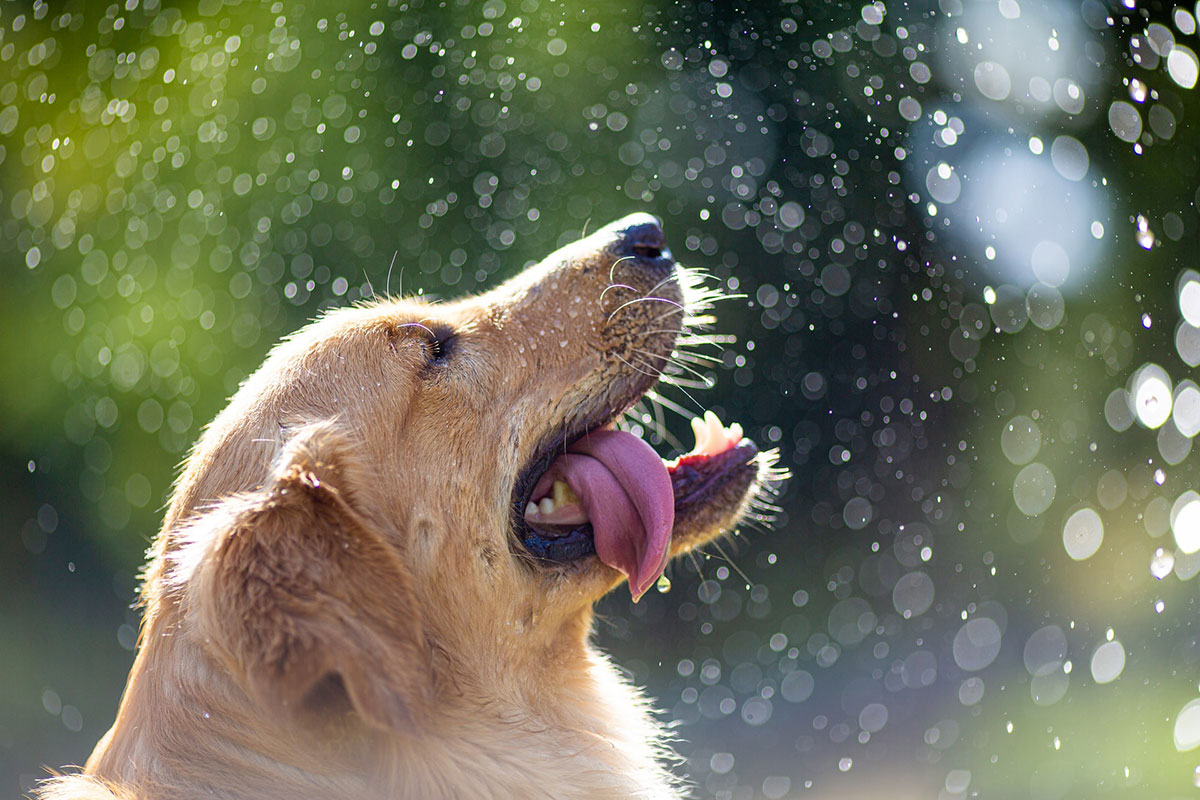Dog owners often wonder why their pets bark a lot at certain people. This could be because of excitement, frustration, fear, or a need to protect. Knowing why is the first step to solving the problem.
When a dog only barks at specific people, it usually means there’s an issue. By figuring out why, dog owners can start to fix the problem.
Key Takeaways
- Understanding why a dog barks is key to solving the problem.
- Dogs bark at specific people for reasons like excitement, frustration, fear, or protectiveness.
- Finding out the cause is essential to solving the issue.
- Dog owners can work on their pet’s barking once they know the reason.
- Selective barking often means there’s an underlying issue that needs fixing.
Understanding Dog Barking as Communication
Dogs bark to share their feelings and needs. They bark to show excitement, alertness, fear, or anxiety.
Different Types of Barks and What They Mean
Dogs bark in various ways, each with its own meaning. Understanding these differences helps you know what your dog needs.
Alert Barks vs. Fear Barks vs. Demand Barks
Alert barks are loud and sharp, warning of danger. Fear barks are higher pitched and may show fear. Demand barks are repetitive, asking for attention or action.
How to Recognize Your Dog’s Barking Patterns
To understand your dog’s barks, watch the context and how they bark. This helps you grasp what they’re trying to say.

How Dogs Use Barking to Express Emotions
Dogs bark to express their feelings. Their barks can show excitement or distress.
The Emotional States Behind Different Barking Behaviors
The emotional state of a bark depends on its sound and the situation. For example, a high-pitched bark might mean anxiety or fear.
Why Selective Barking Is Different from General Barking
Selective barking is when a dog barks at certain people or situations. It’s different from general barking. Knowing this helps address the behavior better.
Common Reasons Why Dogs Bark at Specific People
Dogs bark at certain people for many reasons. These include fear, past experiences, and protective instincts. Knowing why they bark helps us fix the problem.
Fear and Anxiety Triggers
Dogs bark at people because of fear and anxiety triggers. These can come from many places, like their environment and past meetings.
Identifying Signs of Fear-Based Barking
Signs of fear include a tucked tail, avoiding people, and excessive barking at certain individuals.
Common Anxiety Triggers in Dogs
Things that scare dogs include loud noises, new places, and strange people. These can really upset them.

Past Negative Experiences
Past negative experiences greatly affect a dog’s barking. Bad events can leave a lasting mark.
How Dogs Form Negative Associations
Dogs link bad experiences to fear or danger. This happens through adverse experiences.
The Impact of Trauma on Barking Behavior
Trauma makes dogs bark more as a defense. It’s key to find and fix the cause.
Protective and Territorial Behavior
Some dogs bark at people because they feel protective and territorial. This is a natural way to defend their space.
Distinguishing Between Protection and Aggression
It’s important to tell the difference between protection and aggression. Protection is a defense, while aggression is an attack.
Breed Tendencies Toward Protective Barking
Some breeds are naturally more protective. This is because of their history and genetics.
The Role of Appearance in Triggering Barking
Dogs can react to humans based on what they see. A dog’s view of a person can make them bark. This happens when they don’t know or are scared of certain looks.
Physical Characteristics That May Frighten Dogs
Dogs might feel scared by some human features. These include height, size, and face shape.
Height, Size, and Gender Factors
A person’s height and size can scare dogs, if they’re not used to different people. Gender can also matter, as dogs might act differently towards men or women based on past experiences.
Facial Features That Dogs React To
Facial features like beards, mustaches, or odd faces can make dogs bark. Dogs pay close attention to what they see, and strange faces can make them nervous.
Clothing and Accessories That Can Trigger Barking
Clothing and accessories can also make dogs bark. Some things can make a person look scary or odd to a dog.
Uniforms and Work Gear That Commonly Cause Reactions
Uniforms, like those of postal workers or delivery people, can make dogs bark. The special clothes or tools of certain jobs can seem threatening.
Hats, Sunglasses, and Other Problematic Items
Things like hats and sunglasses can change how a person looks in a way that scares dogs. Changing or taking off these items can help reduce barking.
How Scent Influences Your Dog’s Reaction to People
Dogs bark at certain people because of their sense of smell. Their noses are much better than ours, affecting how they react to others.
Understanding Canine Olfactory Sensitivity
Dogs have a more complex sense of smell than humans. This helps them detect many different scents. It’s key to how they respond to people.
How Dogs Process Scent Information
Dogs analyze scents through a detailed olfactory system. When they smell something, they compare it to their memory of smells.
The Connection Between Scent and Memory in Dogs
Smells and memories are deeply connected in dogs. Certain smells can bring up strong memories and emotions. This affects how they act around people.
Common Scents That May Trigger Barking
Some scents make dogs bark because of past experiences. For tips on stopping barking, check out https://barkingbatty.com/how-to-stop-your-dog-from-barking/.
Occupational Scents That Dogs React To
Dogs may bark at people based on their job scents. For instance, a dog might bark at a mailman because of their uniform’s smell.
Other Animals’ Scents on Visitors
Visitors might smell like other animals, making dogs bark. This happens if the dog sees the scent as a threat or doesn’t know it.
Body Language and Movement Patterns That Trigger Barking
Body language and movement patterns are key in making dogs bark. Dogs pay close attention to visual cues. They can easily get startled or scared by certain movements or postures.
How Quick Movements Can Frighten Dogs
Dogs have a natural prey drive response to fast movements. This can make them want to chase or bark. Quick actions, like running or sudden gestures, can seem threatening or exciting. This often leads to barking.
Teaching Visitors How to Move Around Your Dog
It’s important to teach visitors how to calmly interact with your dog. They should avoid sudden movements. Instead, they should move slowly and calmly around the dog. This can help lower the chance of barking.
Postures That Dogs Perceive as Threatening
Certain postures can look threatening or intimidating to dogs, causing them to bark. Knowing these postures is key for managing dog and human interactions.
Direct Eye Contact and Frontal Approaches
In dog communication, direct eye contact is seen as a challenge or threat. Approaching a dog directly from the front is also seen as confrontational. Visitors should be told to approach dogs from the side and avoid direct eye contact.
Looming or Bending Over Dogs
Looming over a dog or bending down to pet them can be scary. It’s best to let the dog come to you. Then, pet them gently without looming or bending over them.
Why Some Dogs Bark at Specific People and How to Fix It
If your dog barks at certain people, identifying the triggers is key. Understanding why your dog barks at some people is crucial.
Identifying the Exact Triggers for Your Dog
To stop your dog’s barking, first find out what causes it. This means looking closely at how your dog reacts.
Conducting Controlled Tests to Pinpoint Triggers
Try controlled tests to see what makes your dog bark. Expose your dog to different things and watch how they react. This helps find out what really sets them off.
Using Video Recording to Analyze Reactions
Video recording can give you great insights. It lets you see your dog’s behavior in detail. You can spot patterns that might not be clear at first.
Creating a Behavior Journal to Track Patterns
Keeping a behavior journal is also helpful. It lets you track your dog’s barking over time. This way, you can see patterns and use them to improve your training plan.
What Information to Record in Your Journal
Your journal should note the setting, people involved, and other important details. This helps you understand when and why your dog barks.
Analyzing Patterns to Develop a Training Plan
After you’ve gathered enough data, you can start to see patterns. Use this information to create a training plan that targets the specific issues you’ve found.
Desensitization Techniques for Reducing Selective Barking
Selective barking can be tough, but desensitization offers hope. It helps dogs react less to certain people.
Gradual Exposure Training Methods
Gradual exposure is key in desensitization. It means slowly introducing the dog to the stimulus (people they bark at).
Setting Up Controlled Exposure Sessions
To start controlled exposure, find where your dog barks. Begin with small steps, keeping them calm.
Determining Your Dog’s Threshold Distance
Finding your dog’s threshold distance is important. It’s when they react to the stimulus. Slowly getting closer helps them get used to it.
Using Positive Reinforcement During Exposure
Positive reinforcement is crucial during exposure. Rewarding calm behavior helps your dog see the stimulus as good.
Choosing the Right High-Value Rewards
Choosing the right rewards is key. Use treats or toys your dog loves.
Timing Your Rewards for Maximum Effectiveness
Timing is everything. Give rewards right after the good behavior to make the connection clear.
By using gradual exposure and positive reinforcement, you can cut down on selective barking. Being consistent and patient is crucial for success.
Counter-Conditioning Strategies That Actually Work
Counter-conditioning can help your dog feel better around feared people. It changes how your dog feels about things they fear. You make the feared thing seem good by linking it to positive things.
Associating Feared People with Positive Experiences
The main goal is to make your dog feel good when they see feared people. There are many ways to do this.
The “Treat Party” Technique
Give your dog treats when they see the feared person. This makes them think of the person as good. Start this when your dog is far away and calm.
Using Play and Toys in Counter-Conditioning
Play and toys can also help. Playing a game or giving a favorite toy when they see the feared person makes them feel happy.
Step-by-Step Counter-Conditioning Process
Following a step-by-step plan is key. It makes sure your dog is safe and learns well. Start with small steps.
Starting with Photos or Videos Before Live Exposure
Start by showing your dog pictures or videos of the feared person. This helps them get used to the person’s look without feeling scared.
Progressing Through Difficulty Levels Safely
When your dog gets more comfortable, you can show them more. But always watch how they feel and don’t push too fast.
Training Commands to Manage Barking Behavior
To tackle selective barking, it’s key to teach your dog specific commands. These can help manage their behavior around certain people.
“Quiet” Command Training Techniques
The “quiet” command is a great tool for controlling barking. Teaching your dog to respond to this command can greatly reduce barking at specific people.
Teaching the Initial “Quiet” Cue
To begin, say “quiet” and hold a treat in front of your dog’s nose. When they stop barking to sniff the treat, give them the treat and praise. This positive reinforcement helps them link the command to the right behavior.
Gradually Increasing Distraction Levels
After your dog learns the “quiet” command, it’s important to add more distractions. Start with small distractions, like people in the distance, and reward your dog for staying quiet. Then, increase the distractions’ intensity over time.
Redirection Methods to Break the Barking Cycle
Redirection is a powerful way to manage barking. By taking your dog’s attention away from what’s causing the barking, you can stop the cycle.
The “Look at Me” Focus Command
Teach your dog the “look at me” command by holding a treat near your face and saying “look at me.” When they look at you, give them the treat. This command shifts their focus away from the trigger.
Using Scatter Treats to Interrupt Barking
Another way to redirect is with scatter treats. When your dog starts barking, scatter treats on the ground or floor to distract them. This breaks the barking cycle and refocuses their attention.
When to Seek Professional Help for Selective Barking
Knowing when to get help for your dog’s selective barking is key. This behavior can be complex, often linked to deeper issues.
Signs That Your Dog’s Behavior Requires Expert Intervention
It’s important to tell normal barking from behavior that needs a pro. Warning signs include persistent barking at specific individuals, accompanied by other behavioral issues such as growling or avoidance.
Distinguishing Between Normal and Problematic Barking
Normal barking is usually triggered by something in the environment and stops when it goes away. But, if the barking doesn’t stop, it might be a sign of a bigger problem.
Warning Signs of Underlying Fear Aggression
Fear aggression can show up as barking, growling, or snapping. If your dog does this, and it’s towards certain people, it’s time to get professional help.
Types of Professional Help Available
There are many ways to get help for selective barking, like certified dog behaviorists and behavior modification programs. These experts can give you tailored advice and training for your dog’s needs.
Finding a Certified Dog Behaviorist
Search for certified dog behaviorists from places like the Certification Council for Professional Dog Trainers (CCPDT) or the International Association of Animal Behavior Consultants (IAABC).
What to Expect from Professional Behavior Modification
A certified dog behaviorist will look at your dog’s behavior, find out what triggers it, and create a special training plan to stop the selective barking.
Managing the Environment to Reduce Trigger Exposure
By controlling the environment, you can reduce the stimuli that trigger your dog’s barking. This involves creating safe spaces for your dog and controlling visitor interactions to minimize exposure to triggers.
Creating Safe Spaces for Your Dog
Creating a safe space for your dog can help them feel secure and reduce barking triggered by stress or anxiety. This can be achieved by setting up a comfortable retreat area where your dog can relax without being disturbed.
Setting Up a Comfortable Retreat Area
Designate a quiet area in your home as a retreat for your dog. This could be a crate or a quiet room with familiar comforts like their bed and favorite toys.
Using Baby Gates and Barriers Effectively
Baby gates and barriers can be used to block access to areas where your dog may be triggered by visitors or other stimuli, helping to keep them calm.
Controlling Visitor Interactions
Controlling how visitors interact with your dog is crucial in reducing trigger exposure. This includes instructing guests on how to behave around your dog to avoid unintentionally causing stress.
Instructing Guests on How to Behave Around Your Dog
Inform your guests about the importance of calm, gentle interactions with your dog. Ask them to avoid direct eye contact or sudden movements.
Managing Deliveries and Service Providers
For deliveries or service providers, consider having them interact with your dog as little as possible. You can also prepare your dog in advance by desensitizing them to the sounds and sights associated with these visits.
Building a More Confident and Socially Adaptable Dog
Long-term socialization is key for a dog’s confidence. It lets them calmly meet new people and places. With regular training and exposure, your dog can become more social.
Long-Term Socialization Strategies for Lasting Change
Start by slowly introducing your dog to new things, people, and places. This makes them feel more at ease in new situations. It also lowers the chance of them barking at certain people.
Celebrating Progress and Maintaining Training Consistency
It’s important to celebrate small wins and keep training up. This reinforces good habits. Regular practice and positive feedback will make your dog’s confidence grow stronger.
Creating Positive Associations with Different Types of People
To help your dog be more social, make sure they have good experiences with people. Reward them for staying calm around different folks. This helps them feel more confident and calm.






